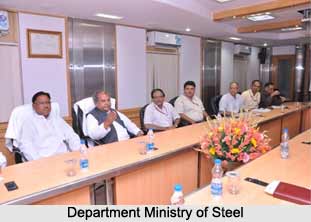 Ministry of Steel is the nodal agency responsible for the co-ordination and planning of the growth and development of Iron and Steel Industry in the country both in the Public and Private Sectors. This includes re-rolling mills, alloy steel and ferro alloy industries, and refractories. This ministry sees to the formulation of policies in respect of production, pricing, distribution, import and export of iron and steel, ferro alloys and refractories as well as the development of industries relating to iron ore, manganese ore, chrome ore and refractories etc. , required mainly by the steel industry.
Ministry of Steel is the nodal agency responsible for the co-ordination and planning of the growth and development of Iron and Steel Industry in the country both in the Public and Private Sectors. This includes re-rolling mills, alloy steel and ferro alloy industries, and refractories. This ministry sees to the formulation of policies in respect of production, pricing, distribution, import and export of iron and steel, ferro alloys and refractories as well as the development of industries relating to iron ore, manganese ore, chrome ore and refractories etc. , required mainly by the steel industry.
Organisation of Ministry Of Steel
The Ministry of Steel is under the overall charge of the Minister of Steel. He is assisted by the Minister of State for Steel. He is assisted by a Secretary to the government of India, an Additional Secretary and Financial Adviser to Government of India, three Joint Secretaries, a Chief Controller of accounts also looking after the accounting matters of the Ministry, one Economic Adviser of the rank of Joint Secretary, Five Directors, Four Deputy Secretaries, Twelve Under Secretaries, One Deputy Director, other Officers and supporting staff and a Technical Wing under the charge of an Industrial Adviser to Government of India.
This article is a stub. You can enrich by adding more information to it. Send your Write Up to content@indianetzone.com




















